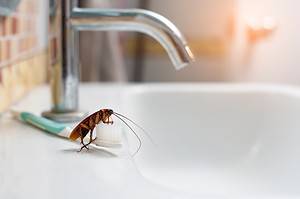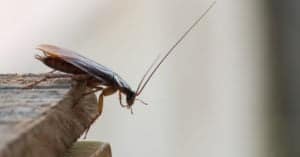Cockroaches are a menace in North Carolina. In fact, if you’re a resident, chances are high that you’ve been visited by the notorious cockroach clan. These unsightly and bothersome creatures can jeopardize your well-being and contaminate your surroundings. But do you know when these insects thrive in North Carolina? And most importantly, how can you prevent and eliminate them from your home? Keep reading to find out all the essential details.
Background Information on Cockroaches
Cockroaches belong to the order Blattodea, encompass approximately 4,600 species spread across more than 460 genera. Despite the vast timespan of 320 million years, these primitive, winged insects bear an uncanny resemblance to their ancient fossils.
Physical Characteristics of Cockroaches
Cockroaches have a flattened oval physique and long antennae. They have a glossy, black, or brown leather-like exoskeleton. Their mouthparts are directed downward. Male cockroaches typically flaunt a pair of wings, but females from certain species either don’t have wings at all or have underdeveloped ones. In tropical climates, it’s not uncommon to find giant cockroaches surpassing 50 mm (2 inches) in length. Winged ones generally exhibit lackluster flying skills.
Reproduction and Life Cycle of Cockroaches
The female of the species produces egg cases known as ootheca. These can be seen hanging out of the female’s body or cleverly stuck away in a safe spot. When the egg case is laid, the delicate white nymphs make their grand entrance into the world. They sport a soft exoskeleton that soon hardens into a shade of brown. The nymph stage lasts anywhere from one to three months.
During a female cockroach’s lifetime, it can pump out 4-20 ootheca, each containing approximately 16 eggs. The eggs hatch within 24 to 38 days. For some species, like the American cockroach, the hatching process takes a little longer, with nymphs emerging after 56 days.
Habitat and Diet of Cockroaches
The cockroach typically thrives in tropical or similarly temperate regions. Only a select few species are considered as pests. While North America can boast around 50 cockroach species, Australia has an astonishing 450 species.
The roach’s diet includes plant and animal products like meat, sugar, and starch. However, they can also eat weird things, including glue, grease, soap, wallpaper paste, leather, book bindings, and even hair. They can survive a long time without food, up to one month for some species.
Types of Cockroaches in North Carolina
North Carolina has a variety of cockroaches, with the German, American, oriental, and brown-banded being the most prevalent. Each type possesses distinctive traits and dwells in diverse regions within the state.
1. German Cockroaches
German cockroaches are the most popular kind of cockroaches in North Carolina. Grown-up German cockroaches grow to be about ⅝ of an inch long. They’re flat, and their skin is light brown. A unique thing about them is they’ve got two black stripes on their back, right behind their head.
German cockroaches are the most invasive type of cockroach in the state. They can sneak into the smallest cracks and reproduce quickly – a female can lay up to 48 eggs at once. They eat anything, from dead leaves to human food, and like warm and moist places. You’ll often find them in kitchens and bathrooms.

Originally native to temperate regions of Europe, German cockroaches are a common pest in many areas including the United States.
©7th Son Studio/Shutterstock.com
2. American Cockroaches
The American cockroach, which scurries around homes across the U.S., is the biggest indoor roach. This pest is otherwise known as the Bombay canary and the water bug. It’s not even from around these parts! Some signs indicate this roach was imported from Africa on boats in the 1600s.
The American cockroach has a reddish-brown color and a figure eight pattern in yellow on the back of its head. Grown-up American cockroaches can vary in size between 1 1/4″ to 2 1/8″ (32-54 mm).
American cockroaches usually dwell in the great outdoors, favoring mild and wet spots such as flowerbeds and beneath leaves. In some areas of the United States, they go by the nickname “palmetto bugs” as they prefer to dwell around or in palmetto trees. You can easily spot these pests in the sewer systems of several American metropolises.

The American cockroach is one of the most common species of cockroaches in the world. They are usually reddish-brown in color, and can grow up to three inches long.
©iStock.com/ViniSouza128
3. Oriental Cockroaches
Oriental cockroaches, also known as water bugs, fancy dim, moist, and chilly places, such as the depths of sinks, laundry machines, and dank cellars. They’re sluggish and less cautious than their counterparts, making them a matter of worry as they tend to crawl through sewage pipes and thrive on filth.
A grown-up oriental cockroach measures roughly one inch long. Both male and female adults have a dark brown, almost black hue, and their bodies have a slightly shiny appearance. Females possess small, useless wing pads and a broader, weightier body while the males only have wings covering three-quarters of their stomachs and seem incapable of flight.
These insects can create up to eight capsules containing 16 eggs each. Those eggs only take around 60 days to hatch at room temperature. An adult female can live up to 26 weeks and produce approximately 200 offspring.
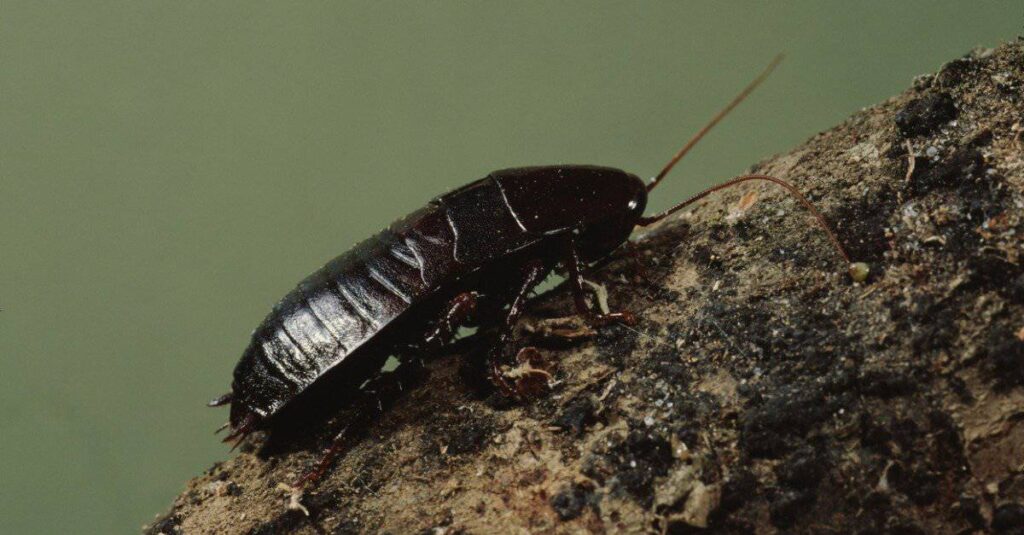
Oriental cockroaches are a type of insect with a dark brownish-black color and can grow up to 1.5 inches in length. They prefer to live in wet and damp places, such as under sinks and around potted plants.
©iStock.com/Weber
4. Brown-Banded Cockroaches
Brown-banded cockroaches are a type of invasive cockroach. What set them apart from the rest of the roach pack are the two light brown bands that stripe across their dark brownish bodies. You can spot these bands on the wings of the adult, but they pop on the nymph’s body. These roaches hitchhiked their way into the United States from Cuba in 1903. They are now found all over the country.
Brown-banded cockroaches are sneaky squatters that hide all over homes, including kitchens, bathrooms, and even behind pictures. They stick around for about 206 days. Females lay up to 14 egg clusters in their lifetime, each holding 10-18 eggs, leading to rapid population growth. These roaches mostly come out at night but sometimes venture out during the day. Their small size and nocturnal habits make them hard to spot.
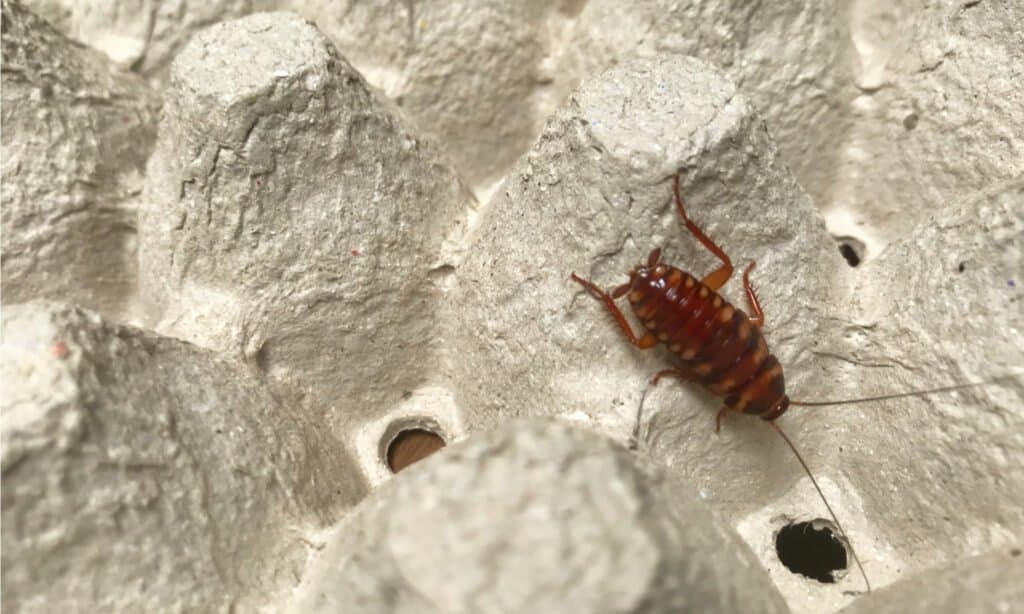
The brown-band cockroach is a small, light-brown colored insect with two distinctive yellow bands running across its body. They like to feed on a variety of household materials, including starch, glue, and paper.
©Freedom my wing/Shutterstock.com
When Is Cockroach Season in North Carolina?
Cockroaches are active all year round, but their activity may vary depending on the season. Here are some general trends:
- Spring: As the temperature climbs, cockroaches become increasingly lively, foraging hungrily for food and water. They may also increase their procreative endeavors. So it’s prime time to scrutinize your home for telltale signs of an infestation, like fecal pellets, eggs, or shed skins.
- Summer: During the summer, the activity of cockroaches reaches its pinnacle, owing to their propensity to flourish in hot and humid environments. Moreover, they may infiltrate your home more frequently to evade predators or harsh weather conditions.
- Fall: With the plummeting temperature levels, cockroaches tend to curtail their movements and scurry off in search of sheltered spots that offer respite from the bitter cold. When the temperature drops below 45 degrees Fahrenheit, cockroaches may enter a state of hibernation. You could stumble upon them lurking in your underground storage, crawl spaces, or under your household equipment and furnishings.
- Winter: It’s the least active season for cockroaches, as they try to survive the cold and lack of food. They may remain dormant or inactive until the temperature rises again. They may be found in your walls, pipes, or insulation.
Why Are Cockroaches a Problem?
Cockroaches are known to be quite hazardous. They’re known to trigger allergies and asthma! They may also carry bacteria that could make you sick if they get on your food.
Cockroach Allergies
Cockroaches can cause allergies. The insects leave behind their excrement, eggs, body parts, and saliva, which contain enzymes that can trigger allergic reactions in people. Kids are more vulnerable than adults to these allergens. Around 63 percent of U.S. homes have cockroach allergens. In cities, that number goes up to as high as 98 percent.
Cockroach-Borne Diseases
Cockroaches pose a concern to humans and pets as they can transmit various diseases. They collect bacteria, viruses, fungi, and parasites from the filth they consume. Afterward, these germs can be dispersed through their feces, saliva, vomit, or body parts. Some of the diseases that cockroaches can transmit include:
- Salmonella
- Typhoid
- Cholera
- Dysentery
- Gastroenteritis
- Leprosy
Some of these diseases can cause serious complications or even death if left untreated.
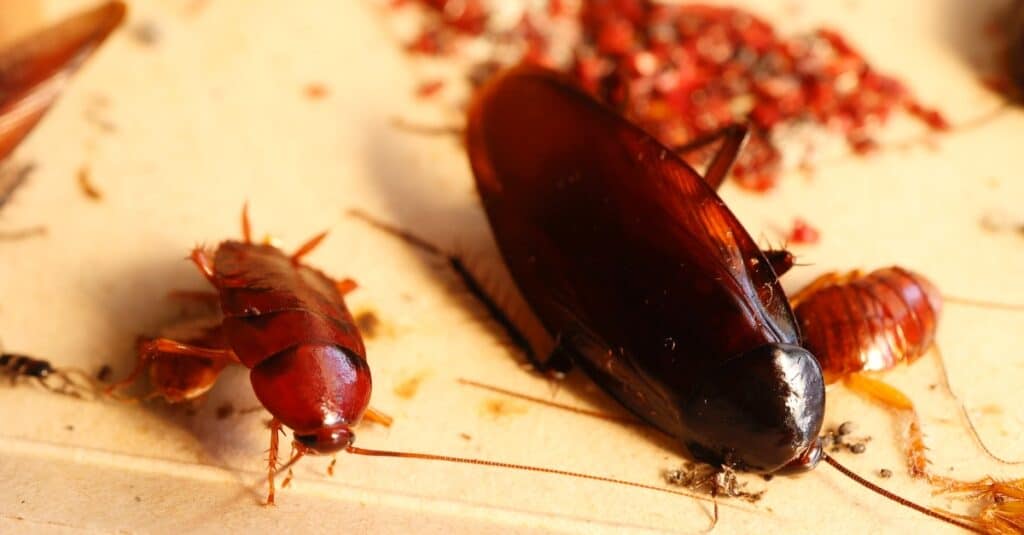
Cockroaches can carry bacteria, parasites, and fungi on their bodies, which can lead to a variety of health problems including asthma, allergies, and other respiratory issues.
©iStock.com/Yusuke Ide
How to Prevent Cockroaches from Invading Your Home
If you want to keep your home free from these unwanted guests, you must take some preventive measures. Ensure you act quickly should you spot any signs of infestation. Here are some tips on how to prevent cockroaches from invading your home:
Keep Your Home Clean and Dry
Cockroaches have a strong affinity for your home due to the ease with which they can get food and liquid refreshment. They typically satiate their hunger by ingesting crumbs, spills, grease, refuse, and pet food.
Moreover, they are incredibly resilient to dehydration, thriving on negligible amounts of water, which can be found in any dampness or humidity in your premises. To prevent cockroaches from accessing these resources, you should:
- Clean your kitchen regularly and wipe down any surfaces with food residue or grease.
- Store food in airtight containers and keep them in the fridge or pantry.
- Dispose of garbage frequently and use a trash can with a tight lid.
- Wash dishes and utensils as soon as possible, and don’t leave them in the sink overnight.
- Sweep and vacuum your floors regularly and remove any clutter that may provide hiding places for cockroaches.
- Fix any leaks or drips in your plumbing and ensure your drains are clear.
- Use a dehumidifier or an exhaust fan to reduce moisture and humidity in your bathroom, basement, or laundry room.
Seal Any Cracks or Gaps
Cockroaches invade your home through small cracks in your walls, floors, doors, windows, or pipes. These openings allow accessible entrance for these repulsive creatures and offer suitable accommodations for their brood. You can stop them from getting in by taking these steps:
- Inspect your home for cracks or gaps and seal them with caulk, foam, or mesh.
- Install weather stripping or door sweeps on your doors and windows to close all gaps.
- Cover any vents or openings with screens or mesh to prevent cockroaches from crawling through them.
- Use steel wool or copper mesh to fill any holes around pipes or wires that may lead to your home.
Use Natural Repellents or Traps
Suppose you desire to prevent cockroaches from invading your dwelling but refuse to employ brutal chemicals or pesticides. In that case, you may use natural repellents or traps capable of producing desirable results harmlessly. Some of them include:
Homemade Cockroach Trap
Grab a glass jar with water, sugar, or caffeine-infused coffee grounds. Next, cap the jar off with a cardboard lid and puncture some perforations. The inviting aroma will lure cockroaches into the jar and they’ll be unable to escape due to the glass’s slickness.
Diatomaceous Earth
Sprinkle your home with Diatomaceous Earth, focusing on zones where you sense cockroach activity. This all-natural substance packs a punch by sapping the moisture from the vermin, ultimately leading to their demise through exoskeleton obliteration.
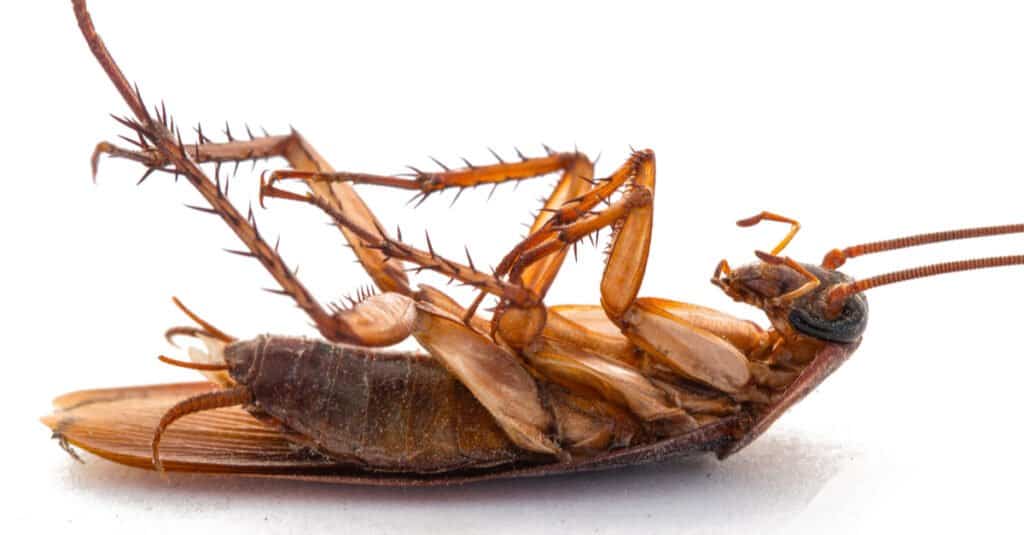
From pesticides and traps, to diatomaceous earth and boric acid, there are many ways to try to rid your home of cockroaches. Be sure to wear gloves if handling a dead roach and dispose of it properly.
©pixfly/Shutterstock.com
Repel Cockroaches with Herbs
Strategic placement of bay leaves, catnip, or mint can do wonders in keeping cockroaches and other pesky insects at bay. These aromatic herbs emit a pungent scent that can effectively deter infestations, particularly in kitchen cabinets, drawers, or pantries.
Sticky Traps and Glue Boards
Use sticky traps or glue boards to catch cockroaches that may wander around your home. Place them near walls, corners, or under furniture where cockroaches may hide.
Boric Acid
Boric acid is a natural compound comprising a mixture of boron and water. This magical potion is widely found in fruits and plants. Although it poses no threat to humans or pets, it is an absolute menace to cockroaches. Once the filthy pests get in contact with boric acid, it fastens onto their wings and limbs. After ingestion, the compound wreaks havoc on their nervous and digestive systems, causing rapid extermination. To utilize the lethal potential of boric acid to obliterate the roach menace:
- Generously dust some of the powdery substance onto a paper plate.
- Center it around a juicy orange peel or a tempting spoonful of peanut butter.
- Leave the bait in areas frequented by the pests.
Roach Bombs
Many opt for unleashing the dreaded roach bombs, also known as foggers. These bombs emit a toxic mist that engulfs indoor surfaces, laying waste to unsuspecting pests. On the surface, roach bombs may seem like an attractive solution to your pest woes, but their hazardous nature should be a cause for concern. We strongly advise against deploying them. Instead, consider opting for more secure and potent alternatives to eradicate the roach invasion.
Call a Professional Pest Control Service
Suppose all prior measures have proven futile in combating the roach population that has taken up residency in your home; in that case, don’t hesitate to enlist the expertise of a certified pest management agency to tackle the issue with greater proficiency. A professional pest control service can:
- Identify the type and source of the cockroach infestation and apply the appropriate treatment methods.
- Use specialized equipment and products to eliminate cockroaches and prevent them from returning.
- Provide advice and recommendations on how to maintain a cockroach-free home.
Parting Thought: Coping with Cockroach Season in North Carolina
North Carolina houses various cockroaches, namely the German, American, oriental, and brown-banded species. These critters can unleash a slew of health hazards and wreak havoc on your prized possessions. Cockroaches are a notoriously resilient species, with an uncanny ability to soldier on without food for an entire month and reproduce at lightning-fast rates.
Maintaining a clean living environment and sealing up any cracks and crevices is imperative to prevent cockroach infestations and damper their nefarious schemes. If you suspect these pests have infiltrated your home, it’s wise to bring in an experienced pest control specialist to administer a foolproof eradication process.
The photo featured at the top of this post is © iStock.com/Wi6995
Thank you for reading! Have some feedback for us? Contact the AZ Animals editorial team.




